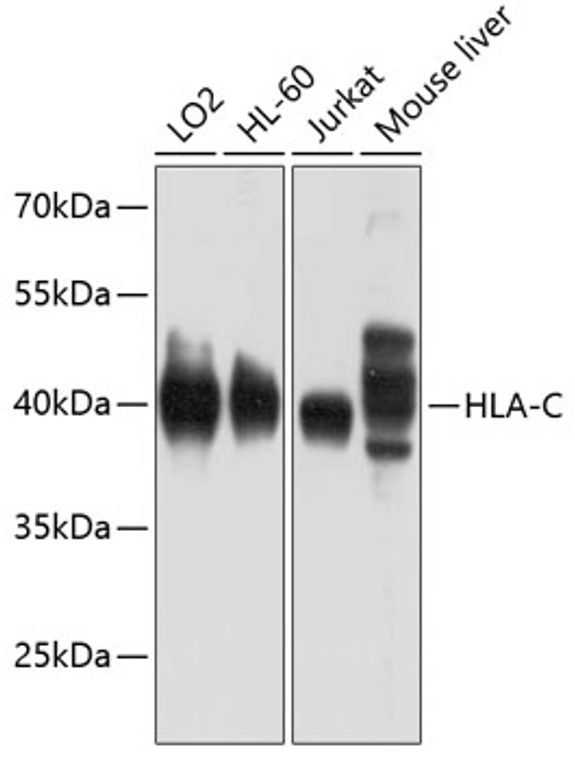| Host: |
Rabbit |
| Applications: |
WB/IF/ICC/ELISA |
| Reactivity: |
Human/Mouse |
| Note: |
STRICTLY FOR FURTHER SCIENTIFIC RESEARCH USE ONLY (RUO). MUST NOT TO BE USED IN DIAGNOSTIC OR THERAPEUTIC APPLICATIONS. |
| Clonality: |
Polyclonal |
| Conjugation: |
Unconjugated |
| Isotype: |
IgG |
| Formulation: |
PBS with 0.02% Sodium Azide, 50% Glycerol, pH 7.3. |
| Purification: |
Affinity purification |
| Concentration: |
Lot specific |
| Dilution Range: |
WB:1:500-1:2000IF/ICC:1:50-1:200ELISA:Recommended starting concentration is 1 Mu g/mL. Please optimize the concentration based on your specific assay requirements. |
| Storage Instruction: |
Store at-20°C for up to 1 year from the date of receipt, and avoid repeat freeze-thaw cycles. |
| Gene Symbol: |
HLA-C |
| Gene ID: |
3107 |
| Uniprot ID: |
HLAC_HUMAN |
| Immunogen Region: |
25-308 |
| Specificity: |
Recombinant fusion protein containing a sequence corresponding to amino acids 25-308 of human HLA-C (P30499). |
| Immunogen Sequence: |
CSHSMKYFFTSVSRPGRGEP RFISVGYVDDTQFVRFDSDA ASPRGEPRAPWVEQEGPEYW DRETQKYNRQAQTDRVSLRN LRGYYNQSEAGSHTLQWMCG CDLGPDGRLLRGYDQYAYDG KDYIALNEDLRSWTAADTAA QITQRKWEAAREAEERRAYL EGTCVEWLRRYLENGKESLQ RAEHPKTHVTHHPVSDHEAT LRCWALGFYPAEITLTWQWD GEDQTQDTELVETRPAGDG |
| Tissue Specificity | Ubiquitous. Highly expressed in fetal extravillous trophoblasts in the decidua basalis (at protein level). |
| Post Translational Modifications | N-linked glycosylation at Asn-110 is required for efficient interaction with CANX and CALR chaperones and appropriate HLA-C-B2M folded conformers prior to peptide loading. |
| Function | Antigen-presenting major histocompatibility complex class I (MHCI) molecule with an important role in reproduction and antiviral immunity. In complex with B2M/beta 2 microglobulin displays a restricted repertoire of self and viral peptides and acts as a dominant ligand for inhibitory and activating killer immunoglobulin receptors (KIRs) expressed on NK cells. In an allogeneic setting, such as during pregnancy, mediates interaction of extravillous trophoblasts with KIR on uterine NK cells and regulate trophoblast invasion necessary for placentation and overall fetal growth. During viral infection, may present viral peptides with low affinity for KIRs, impeding KIR-mediated inhibition through peptide antagonism and favoring lysis of infected cells. Presents a restricted repertoire of viral peptides on antigen-presenting cells for recognition by alpha-beta T cell receptor (TCR) on HLA-C-restricted CD8-positive T cells, guiding antigen-specific T cell immune response to eliminate infected cells, particularly in chronic viral infection settings such as HIV-1 or CMV infection. Both the peptide and the MHC molecule are recognized by TCR, the peptide is responsible for the fine specificity of antigen recognition and MHC residues account for the MHC restriction of T cells. Typically presents intracellular peptide antigens of 9 amino acids that arise from cytosolic proteolysis via proteasome. Can bind different peptides containing allele-specific binding motifs, which are mainly defined by anchor residues at position 2 and 9. Preferentially displays peptides having a restricted repertoire of hydrophobic or aromatic amino acids (Phe, Ile, Leu, Met, Val and Tyr) at the C-terminal anchor. ALLELE C*01:02: The peptide-bound form interacts with KIR2DL2 and KIR2DL3 inhibitory receptors on NK cells. The low affinity peptides compete with the high affinity peptides impeding KIR-mediated inhibition and favoring lysis of infected cells. Presents to CD8-positive T cells a CMV epitope derived from UL83/pp65 (RCPEMISVL), an immediate-early antigen necessary for initiating viral replication. ALLELE C*04:01: Presents a conserved HIV-1 epitope derived from env (SFNCGGEFF) to memory CD8-positive T cells, eliciting very strong IFNG responses. Presents CMV epitope derived from UL83/pp65 (QYDPVAALF) to CD8-positive T cells, triggering T cell cytotoxic response. ALLELE C*05:01: Presents HIV-1 epitope derived from rev (SAEPVPLQL) to CD8-positive T cells, triggering T cell cytotoxic response. ALLELE C*06:02: In trophoblasts, interacts with KIR2DS2 on uterine NK cells and triggers NK cell activation, including secretion of cytokines such as GMCSF that enhances trophoblast migration. ALLELE C*07:02: Plays an important role in the control of chronic CMV infection. Presents immunodominant CMV epitopes derived from IE1 (LSEFCRVL and CRVLCCYVL) and UL28 (FRCPRRFCF), both antigens synthesized during immediate-early period of viral replication. Elicits a strong anti-viral CD8-positive T cell immune response that increases markedly with age. ALLELE C*08:01: Presents viral epitopes derived from CMV UL83 (VVCAHELVC) and IAV M1 (GILGFVFTL), triggering CD8-positive T cell cytotoxic response. ALLELE C*12:02: Presents CMV epitope derived from UL83 (VAFTSHEHF) to CD8-positive T cells. ALLELE C*15:02: Presents CMV epitope derived from UL83 CC (VVCAHELVC) to CD8-positive T cells, triggering T cell cytotoxic response. |
| Protein Name | Hla Class I Histocompatibility Antigen - C Alpha ChainHla-CHla-CwHuman Leukocyte Antigen C |
| Database Links | Reactome: R-HSA-1236974Reactome: R-HSA-1236977Reactome: R-HSA-198933Reactome: R-HSA-2172127Reactome: R-HSA-6798695Reactome: R-HSA-877300Reactome: R-HSA-909733Reactome: R-HSA-9705671Reactome: R-HSA-983170 |
| Cellular Localisation | Cell MembraneSingle-Pass Type I Membrane ProteinEndoplasmic Reticulum MembraneSingle-Pass Membrane Protein |
| Alternative Antibody Names | Anti-Hla Class I Histocompatibility Antigen - C Alpha Chain antibodyAnti-Hla-C antibodyAnti-Hla-Cw antibodyAnti-Human Leukocyte Antigen C antibodyAnti-HLA-C antibodyAnti-HLAC antibody |
Information sourced from Uniprot.org
12 months for antibodies. 6 months for ELISA Kits. Please see website T&Cs for further guidance







